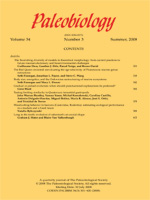Cheek teeth of some mammalian herbivores exhibit pronounced changes in occlusal size and shape through wear, purportedly caused by strong curvature. Such changes are extreme in the upper cheek teeth of extinct, dentally archaic lagomorphs. Morphologic and taxonomic turnover in lagomorphs suggests that these dentally archaic forms may have been unable to develop hypselodont (ever-growing) cheek teeth. This study investigates how the interaction of tooth shape and wear can cause occlusal size and shape changes, and potentially impose structural constraints on crown height. These constraints may help explain extinction of mammals with teeth like archaic lagomorphs, evolution and diversification of other mammalian herbivores during the late Miocene, and the relative paucity of hypsodont cheek tooth shapes in extant mammals.
I first quantify two-dimensional curvature accounting for shape differences observed in hypsodont teeth, P4s of the archaic lagomorphs Russellagus and Hesperolagomys, which exhibit pronounced change with wear, and Ondatra lower incisors, which show minimal change with wear. Using this quantification, I generate theoretical curvature morphologies and describe a geometric model of tooth wear that generates values for qualitative and quantitative aspects of the occlusal surface at different wear stages. Modeled results of wear surface topography and dimensions closely correspond to observed patterns in Russellagus, Hesperolagomys, and Ondatra. Model results on wear in theoretical tooth morphologies identify two major shape factors influencing wear: orientation of the wear surface (incisor-like or cheek-tooth-like), and tooth curvature (“concentric” or “nonconcentric”). Modeled wear also suggests two geometric constraints on crown height. Teeth with nonconcentric curvatures can have crown height limited by potential tooth area. “Incomplete wear” in any tooth can present severe constraints on increasing crown height, causing structurally untenable morphologies in very tall-crowned to hypselodont teeth.





